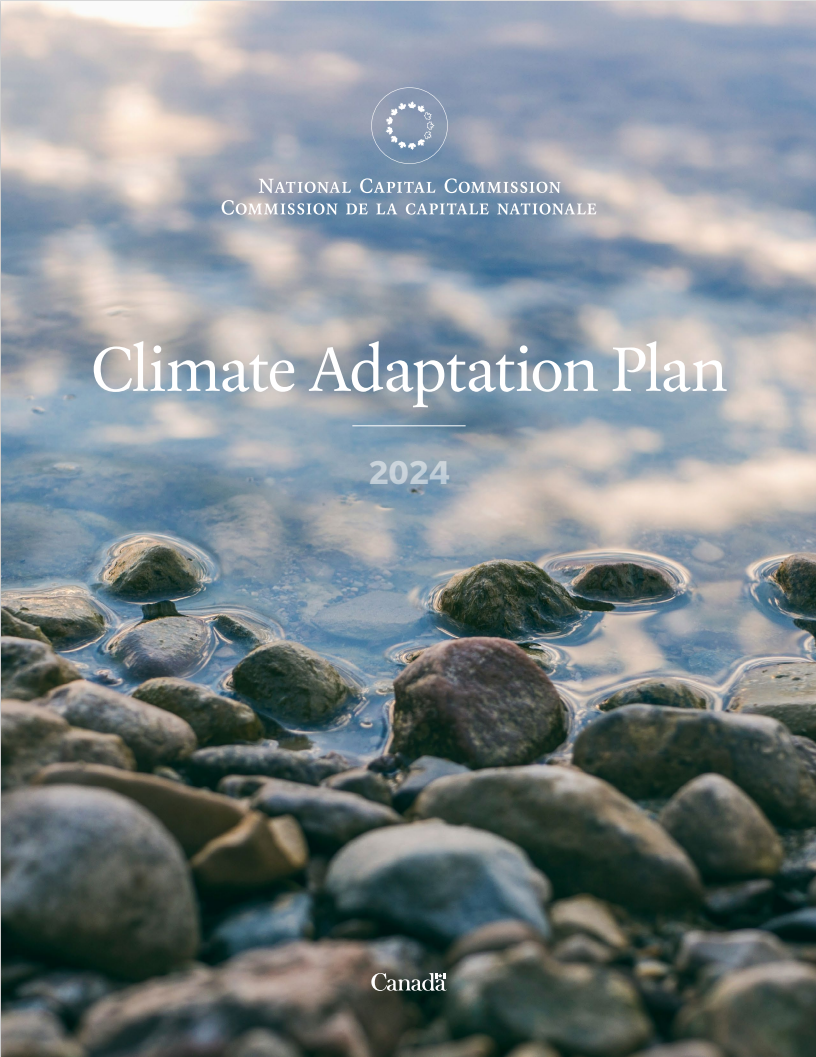
The impact of climate change is being felt globally and locally. We can fully expect it to continue to intensify and affect the National Capital Region. In 2024, the NCC approved its first Climate Adaptation Plan to help increase the resilience of its operations.
As outlined in the NCC’s Sustainable Development Strategy 2023–2027, our Climate Adaptation Plan addresses the most significant potential impacts of climate change on the NCC’s operations. We will also assess climate risk for every one of our major projects.
About the Plan
The plan includes 35 actions to manage the most significant potential impacts identified in the Climate Change Vulnerability and Risk Assessment. Delivering on these actions will help us deliver on our mandate despite climate disruptions, contributing to a more resilient National Capital Region.
The plan follows these principles:
- Mainstream adaptation into existing processes, policies and decision-making mechanisms;
- Protect green spaces;
- Prioritize climate mitigation co-benefits and avoid conflicts;
- Prioritize health impacts and safeguard vulnerable populations;
- Create partnerships for regional sustainability;
- Adopt a long-term view.
The 35 actions of the Plan are grouped under these goals:
- Corporate Policy and Guidelines: Include climate risk in the making of NCC’s policies, guidelines and rules.
- Capacity Building: Provide staff with training, decision-support tools, and resources to manage climate risk.
- Operational Planning and Management: Consider climate risk in daily operations and asset management and planning.
- Emergency Response and Business Continuity: Prepare for extreme weather events and streamline response and recovery.
- Capital Investment and Funding: Consider climate risk in capital, budgeting and financial decision-making processes.
- Data Deployment: Improve the collection and use of relevant local climate data and information.
Background
The plan builds on the 2020 climate projections study and the 2022 climate vulnerability and risk assessment.
Climate Projections
In 2020, we commissioned a climate change projections study for the National Capital Region with the City of Ottawa. The study provides a range of results for the moderate to high emission scenarios for 3 projection horizons: 2030s (2021–2050), 2050s (2041–2070) and 2080s (2071–2100).
A complete and updated version of the datasets presented in this report is available on the City of Ottawa’s Open Ottawa website.
Key findings
The study concluded that, by the 2050s, under a high-emission scenario, we can expect to see many changes in the National Capital Region.

Earlier springs
- Spring will start two weeks earlier.

Hotter summers
- There will be four times as many days over 30°C.

Later autumns
- Fall will start three weeks later.

Shorter winters with less snow and fewer cold days
- Winter will be shorter by five weeks.
- Annual snowfall will decrease by 20%.
- There will be 35% fewer days below -10°C.
- There may be more freezing rain.

A warmer and wetter climate
- Annual precipitation (spring, fall, winter) will increase by 8%.
- The maximum daily precipitation will increase by 14%.
- The annual average temperature will increase by 3.2°C.
- Warming will create favourable conditions for storms, tornadoes and wildfires.
Climate Vulnerability and Risk Assessment
The NCC is vulnerable to climate hazards that magnify existing challenges and create new ones. In our 2022 Climate Vulnerability and Risk Assessment, we have evaluated our vulnerability to 27 climate hazards for NCC-managed assets, operations and programs.
The NCC has also already commissioned a risk assessment of the effects of climate change on the Rideau Canal Skateway. In 2022, based on this assessment, the NCC entered a four-year partnership with Carleton University.
Key Findings
This study found a total of 124 potential impacts on NCC business lines. Of these,
- 61 need immediate action
- 38 need a plan to address the risk
- 25 need minor controls and monitoring
Of the 61 potential climate impacts that need immediate action, approximately
- 36% of the risks are related to extreme heat
- 36% are related to changes in precipitation
- 20% are related to extreme weather events, including extreme blizzards, ice storms, extreme winds and so on
- 8% are related to seasonable variability
The following NCC sectors have the greatest number of overall risks, and the greatest number of high risks:
- infrastructure and operations
- natural resources and parks
- buildings
Review process
To stay up to date, we will regularly acquire new climate projections, reassess climate vulnerabilities and risk posed by the region’s evolving climate. We will determine new measures through an updated adaptation plan to maintain its resilience to climate change.
Documents
- Climate Adaptation Plan (7.651 MB)
- Climate Vulnerability & Risk Assessment Report (19.945 MB)
- Climate Projections for the National Capital Region Report, Executive Summary (982.046 KB)
- Climate Projections for the National Capital Region Report, Volume 1: Results and Interpretation for Key Climate Indices (8.903 MB)
- Climate Projections for the National Capital Region Report, Volume 2: Plots and Tabular Data for All the Climate Indices (131.929 MB)
- Risk assessment - Climate change on the Rideau Canal Skateway - July 2021 (6.574 MB)